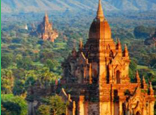Myanmar: Rising from stagnation & ruins
NAY PWI TAW: For nearly 50 years, Myanmar or N Burma was isolated from the rest of the world with the military rule forcibly enforced throughout this vast Southeast Asian country of more than 100 ethnic groups.
With decades of stagnation and isolation, Myanmar descended from being the second wealthiest nation in the region during the British rule, to being one of the poorest in the world, despite its huge deposits of jade, gold, gems, oil and natural gas.
English was widely spoken in the country and there were oil wells and mines for tungsten, tin, lead and silver, all destroyed during World War II.
With not much infrastructure to boost of, nor modern technology that connects everyone to the rest of the world, Myanmar faces the daunting task of rebuilding itself and joining other tourism powerhouses in Asia like Thailand, which welcomes more than 20 million tourists annually.
In May of 2015, the Tourism Authority of Thailand (TAT) partnered with Myanmar to host a select group of tour operators and media from Germany, Switzerland, UK, Italy, among others in Europe, the Middle East, the US, Russia, Asia and Africa, to get their pulse on the possibility of promoting Myanmar to potential tourists.
For many German and Swiss tour operators, Myanmar’s laid-back charm is enough to attract European tourists, especially those who are looking for nature and environmental thrills.
For the Italians, Myanmar’s charm alone is not enough. Tying it up with Thailand’s vibrant tourism atmosphere and its world-class facilities and services must go hand-in-hand.
“There’s nothing much to see and experience right now in Burma,” says one Italian tour operator. “This is like Thailand 20 or 30 years ago. For Italians, it’s important to have modern facilities, shops and world- class services.”
The positive signs in Myanmar’s tourism industry are already apparent. Investors from at least 10 countries – Singapore, Vietnam, Thailand, Hong Kong, Japan, Malaysia, UK, Korea, Luxemburg and the UAE – have already proposed to build multi-million-dollar hotels and shopping complexes in various areas.
The number of tour operators and tour guides are also consistently increasing. As of 2015, there were already close to 6,000 licensed tour guides in the country.
Chiang-Mai: Gateway to Burma Chiang-Mai in Northern Thailand offers a glimpse of hope with plans for regular flights to Myanmar’s Mandalay, the religious capital of the country and the second largest city.
Located in a mountainous area, Chiang-Mai offers travelers not just a gateway to Myanmar but its own unique environment as well.
Dotted with hundreds of elaborate temples in remarkable shapes and sizes, some dating back to the 14th and 15th century, Chiang- Mai is best known for its relaxing vibe, fabulous food, old Thai charm and more.
The place offers a unique glimpse into the old Thai culture, a host of adventure camps, elephant sanctuaries, souvenir markets, shopping, Thai cooking schools and a lot more.
Ancient Treasures
Myanmar has 14 states and regions.
Outsiders most often visit the old capital, Rangon or Yangoon, which offers a glimpse of a gone-by era—a mix of colonial buildings and gilded Buddhist pagodas defining its skyline.
Mandalay, the last Royal capital and considered the center of Burmese culture, will show you the commercial side of the country with lots of trading activities, mostly from the continuing influx of Chinese immigrants.
Here, you will also find the Kuthodaw Pagoda which contains the world’s largest book and Shwe Nandaw Monastery, one of the finest examples of traditional Myanmar-style wooden monastery building in the country.
South of Mandalay is the 200-year-old U- Pein Bridge, said to be the longest and oldest teak bridge in the world.
In Mandalay, you will also have the chance to visit the Mahagandayone Monastery where you can get a glimpse of the monastic way of life with monks from different ages.
In the not so distant ancient city of Bagan, your eyes will feast on majestic temples and pagodas, built one after another in a vast land.
Some of the best places to visit are the golden Shwezigone Pagoda, Gupyaukgyi Pagoda, noted for its frescoes and stucco works, and Ananda Temple, a masterpiece of the Mon architecture.
The Indian government even donated $2 million to Myanmar to restore this ancient architectural heritage.
Bagan is also known for artisans craft, paintings, carvings and other souvenir items. The famous British novelist George Orwell who penned the world favorite The Animal Farm is said to have lived in Bagan for sometime.
Apart from its impressive variety of Buddhist religious and cultural heritage, Bagan is also famous for its exquisitely decorated lacquer ware and puppetry.
Nay Pwi Taw, the new capital, houses modern hotels and infrastructure. The area houses museums, government offices and shops envisioned to become the country’s hub for conferences and major events.


